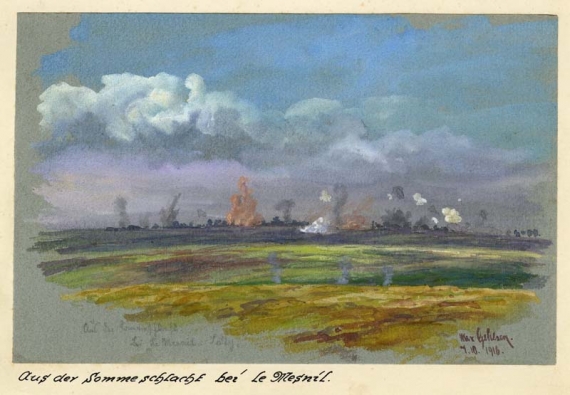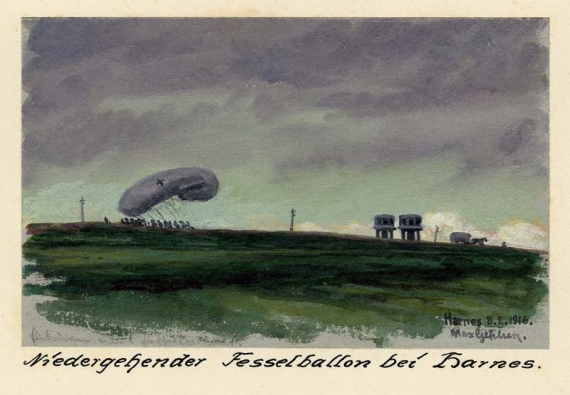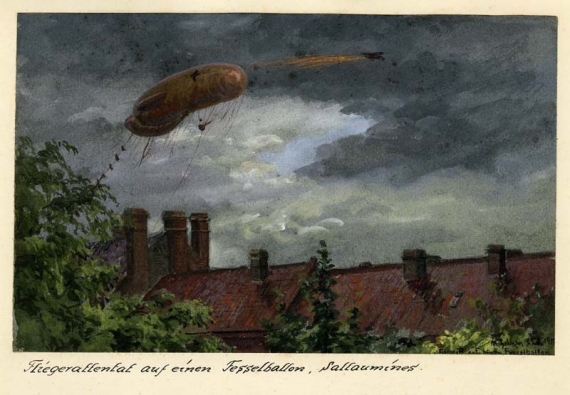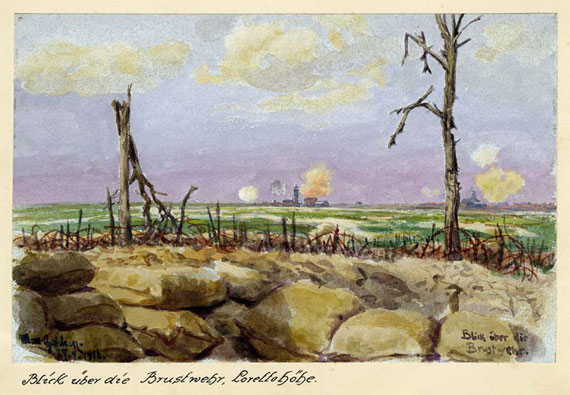Max GEHLSEN, Lorette Hill. British attack following an explosion , 1916, gouache on cardboard, 15 x 22.5 cm
The flaming projectiles which are all the more visible during the night seem to be heading towards the trenches where the German soldiers are located. The attack, which is somewhat distanced, and the nocturnal vision which is favoured by the artist, give the projectiles aimed at the soldiers the aspect of a latent threat, almost surreal.
Departmental archives of Pas-de-Calais 47 FI 16_2
Max GEHLSEN, Lens and Lorette Hill, Loison, 15 July 1916, watercolour on cardboard, highlights on gouache, 14.5 x 22.5 cm
Behind the agricultural land is a row of houses on an almost horizontal line. In the background lies the town of Lens, with its church being visible on the left side of the image. The smoke which is visible in the distance, close to Lorette Hill, comes from the German front line. The composition of the watercolour shows a certain distance of the artist from the front line fighting, which is itself portrayed through some visual « barriers » such as the edges of fields or rows of houses, which separate the onlooker from the front line. The onlooker can, thanks to the smoke, realise the presence of the combats, but it is not possible to know more about what is happening in the distance.
Departmental archives of Pas-de-Calais 47 FI 13_2
Max GEHLSEN, Battle of the Somme close to Mesnil-en-Arrouaise7 October 1916, watercolour on cardboard, gouache highlights , 14.5 x 22.5 cm
The clouds of smoke from the explosions and combat on the front line are shown on the horizon, like a distant mirage. In this watercolour Max GEHLSEN illustrates the destructive power of the artillery which took on its dimension of being a destructive power in the Great War. The conflict was focused more on being a war of positions, and the most effective way of conquering new enemy trenches was to massively bomb these, before assaults were led by foot soldiers.
Departmental archives of Pas-de-Calais 47 FI 35_2
Max GEHLSEN, Sallaumines. Aerial attack, 9 January 1916, watercolour in cardboard, gouache highlights, 20 x 13.5 cm
This watercolour shows the traces left by the air assaults, which also occurred in the fighting.
Departmental archives of Pas-de-Calais 47 FI 125_2
Max GEHLSEN, Descent of a balloon close to Harnes, 8 February 1916, watercolour on cardboard, gouache highlights, 9.5 x 13 cm
Departmental archives of Pas-de-Calais 47 FI 109_1
Max GEHLSEN, Sallaumines, An air attack against a captive balloon, 25 April 1916, watercolour on cardboard, highlights on gouache, 14.5 x 22.5 cm
There are very few works by Max GEHLSEN showing air attacks. The dark winter sky at Sallaumines, is crossed by an aircraft, with the shooting shown by yellow-orange lines. Their target is a captive balloon located on the left side of the watercolour.
Departmental archives of Pas-de-Calais 47 FI 35_1
Max GEHLSEN, Lorette. A glance above the parapet, 27 April 1916, watercolour on carton, 14.5 x 22.5 cm
The trench, behind which the landscape can be seen, is most likely located at the foot of Lorette Hill, taken from the Germans by the French in May 1915. The sandbags make way for the parapet, strewn with cut up trees and rows of barbed wire. Beyond this we can make out green fields, and the skyline of a village with its church, houses and the head frame of a mine to the right. The clouds of smoke close to the village bear witness to artillery fire. This representation does not focus on the enemy lines, but instead highlights the damage and destruction caused by war, with trees having been destroyed in the foreground, and the devastation caused by bombing in the background.
Departmental archives of Pas-de-Calais 47 FI 48_2


























